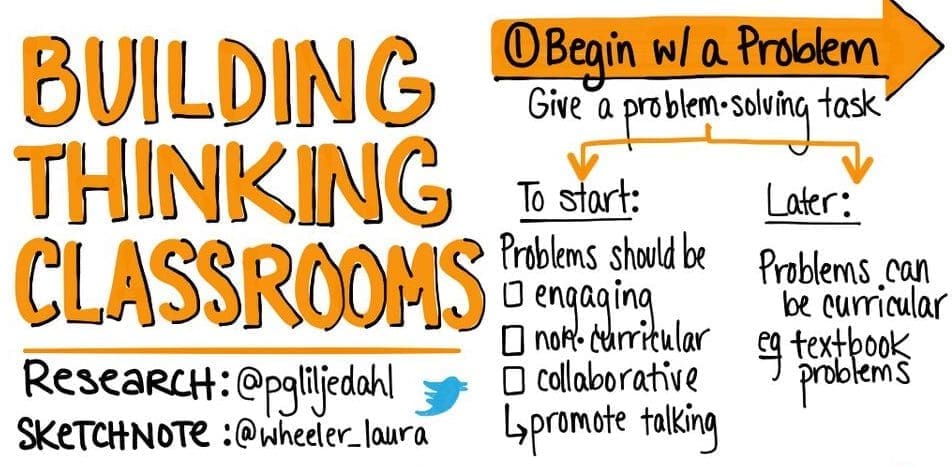The workshop I was most excited to attend at CAMT this summer was Building Thinking Classrooms with Peter Liljedahl. Liljedahl, for anyone who doesn’t know, is a mathematics professor and researcher who studies how students learn math. According to his biography on his own website, “his research interests are creativity, insight, and discovery in mathematics teaching and learning; the role of the affective domain on the teaching and learning of mathematics; the professional growth of mathematics teachers; mathematical problem solving; numeracy; and engaging student thinking.”
Liljedahl was not like most of the other CAMT presenters- there was no “turning and talking,” or trying out activities or having teachers solve math problems. His was a straight up lecture about current math research, and it was fascinating. I left and immediately bought two of his books which I will link below.
He stressed that most students in math class are not actually thinking about math; they are only mimicking what the teacher is doing.
His main point in a few words was that to get students thinking about math, teachers have to BREAK INSTITUTIONAL NORMS. (this reminded me so much of my experience visiting Ron Clark Academy.) Here are a few of the research based solutions I put in my notes during his lecture.
A Pinterest classroom is not a thinking classroom.
Students need to be in an environment where they feel free to make mistakes. A classroom that is too perfect communicates the message that perfection is expected. Liljedahl also stressed that there should be no “front” to the classroom. The teacher should talk to the class from a variety of locations around the room and students should be working in all areas of the room.
Students should be standing.
Standing is linked to increased energy and improved mood. It also allows for more nonverbal communication within groups. Students who are standing feel less anonymous and feel a decreased pull toward off task behavior (zoning out, checking phone, etc.)
Instructions should be given verbally.
This leads to students discussing what to do instead of focusing on a page.
Optimal group size is 2 people in grades K-2 and 3 people in grades 3 and up. These groups should be randomized twice a day in elementary classrooms and every class in secondary.
Truly random groups that are changed often are more effective than either teacher selected or student selected groups. (He told us that often teachers think if they put their best students together they will do amazing work, but research shows that they actually don’t.)
According to Liljedahl’s research, “When randomization was done frequently – twice a day in elementary classrooms and every class in middle and secondary classrooms – the changes in classroom behaviour was profound. Within two to three weeks:
- students become agreeable to work in any group they were placed in;
- there was an elimination of social barriers within the classroom;
- mobility of knowledge between students increased;
- reliance on the teacher for answers decreased;
- reliance on co-constructed intra- and inter-group answers increased;
- engagement in classroom tasks increased;
- and students became more enthusiastic about mathematics class.
The optimal writing surface is vertical and non permanent (such as a vertical whiteboard.)
All work should be visible to the entire group, the teacher, and the other groups. There should be only one writing instrument per group so that students have to work together and discuss what they are doing. Liljedahl writes, “it is clear that non-permanence of surfaces is critical for decreasing time to task, as well as improving enthusiasm, discussion, participation, and persistence. It also increases the non-linearity of work which mirrors the actual work of thinking groups. Making these non-permanent surfaces vertical further enhances all of these qualities, as well as fostering inter-group collaboration. “
Building Thinking Classrooms Liljedahl Book and Resources
Here is the article describing his detailed research on each of the above points. I would highly recommend buying his book Building Thinking Classrooms in Mathematics. The book is written for teachers of all grades K-12 and covers everything listed above in addition to these other topics.
- What types of tasks we use in a thinking classroom
- How we form collaborative groups
- Where students work
- How to arrange the furniture
- How to answer questions
- When, where and how tasks are given
- What homework looks like
- How to foster student autonomy
- How to use hints and extensions
- How to consolidate a lesson
- How students take notes
- What we choose to evaluate
- How to use formative assessment
- How to grade
- Pulling all the practices together
In addition to the book, Liljedahl has a website where you can find teacher resources, numeracy tasks, “good problems” and even card tricks! Also look for many Facebook groups devoted to Building Thinking Classrooms as well as podcasts with Liljedahl available online.



